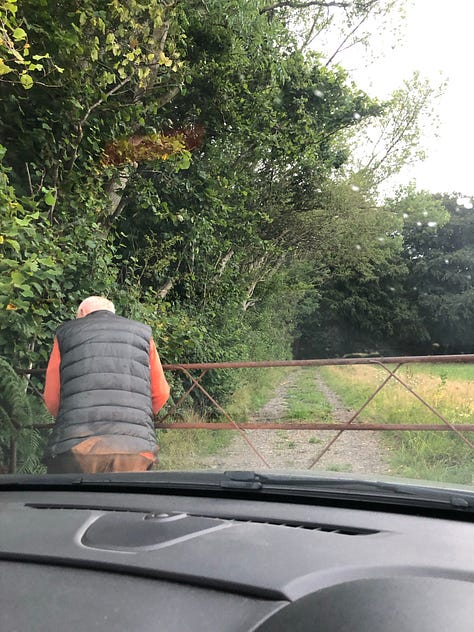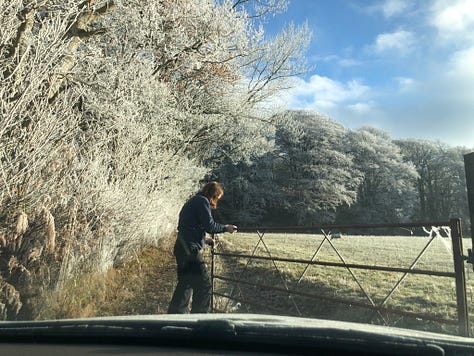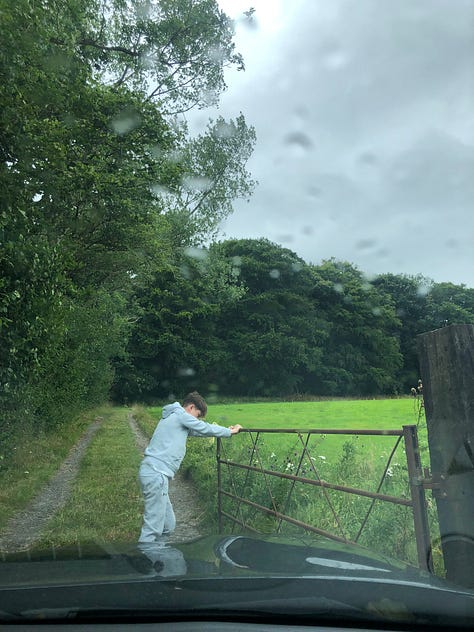My Dad wrote about more than one field. There was Antony Gormley’s of course. I will share more on that another time, when I can find the book I know I have somewhere, stuffed full of post-it notes, dated photographs, scribblings, observations. Memory tells me we saw the exhibit at the Graves Art Gallery in Sheffield - or was it Millennium? Dad records that we also saw it somewhere in Llandudno, and I suppose it must have come to our favourite Yorkshire Sculpture Park too, but I can’t recall either of these occasions to mind. (I will touch on art as a theme at times in these writings - whether related to, directly inspired by or completely irrelevant to the goings-on at our Hafod yr Afr.)
"Field for the British Isles" - Antony Gormley
The house that we grew up in, once known as simply “The Bungalow” - for it was - Dad grandly renamed “Field End” for it was situated at the end of a vast field, the other end of which could not be seen by eye from the garden. A field filled with ancient trees, cattle drinking troughs (and cattle) and bound by long hedges, woodland buffers, walls and ditches - our childhood outdoor runaround adventure-scape. Many scenes played out there - for us all, and for him professionally too, as this was the largest field in the grounds of Losehill Hall, the Peak National Park’s study centre which he was the boss of for some 25 years or so. Hosting there the elm-wood craft-work of renowned Snowdonia-based sculptor and artist David Nash (as part of the “Art in National Parks” programme in 1987) was a highlight of his career there - another time, another time.
The field which I share with you today, is described below - I’ll let him tell you about it, in his own words.
“The Field. No not Antony Gormley’s. The Townsend’s. At Hafod. The top field. Above the cottage. The one Newborough has just sold to our new-ish neighbours. Disaster looms? Maybe, if their previous track record is anything to go by. She (who was a he) lives nearby in a large, neighbouring property with husband. Nouveaux riches. In the worst possible taste. Our water supply field is her zoo. Llamas, donkeys, weird breeds of duck, sheep and geese proliferate. Peacocks screeching impinge a little. Otherwise we at Hafod bask in our isolation and snug surroundings. I sit now in the yard in the sun. A nuthatch knocks a hazelnut (I would guess) on a branch in the orchard, now sadly neglected and fruitless. Sheep are all around ‘mowing’ Mr Williams’ ‘lawns’. I watched them for ages this morning nibbling away doing a super job on the grass of Hafod’s gardens. Saving me a lot of work. The location is perfect. River Dee below with Llangar medieval church perched above it. In-bye land (as they say in Derbyshire) surrounds us. Fields of grass for sheep and cattle. The aforesaid field is special because it hosted much activity of the generations. Mostly play but certainly some spiritual solitude and companiable walks. Then the forest climbing up the slopes overlooked by Berwyn mountain moorland. Who could ask for anything more? Perhaps a lake? Well, there is the Corwen reservoir tucked into the forest on route to Liberty Hall. I came here this weekend dreading change. Fearing the worst. Expecting to find bulldozers at work. “Landscaping.” Luckily nothing has happened yet. A bit of new fencing to delineate the territory. So, last night turned into a pilgrimage. I ventured on to the field, camera in hand. I wanted to capture a little of its character as we all recalled it. Just a bit of upland Wales. Originally reclaimed from the indigenous forest. Worked over the centuries to provide grazing. Bracken kept at bay by cattle’s hooves. Seedlings by the sheep. Thistles and nettles cut annually by the farmer - Bob Roberts when mother bought the place and now Mr (we-don’t-know-his-first-name) Williams. What next I wonder? I digress.
The sun shone its shadows photogenically. I clicked away trying to capture some of the spirit of the field. My crab apple tree (appreciated more since the gift from a friend – “The Celtic Wisdom of Trees”) made a nice backdrop to the remnants of the stone/slate slab walls that enclosed even smaller fields within originally. The roche moutonées would look like ordinary rocky lumps of hillside but would remind me of romantic dreams lately. The gate up to the moors would bring back pleasant memories of a time we came across Bob and Glyn counting sheep up on the moor. JD carved nearby is a bittersweet memory. Next to it PMT could be me – but is ahh! The marriage that never happened! (thank god!) The big ash I think of as Sam’s because he slid and slid on the winter ice below its branches on his homemade “sled” of plastic bags. It was the background to Paula’s kite flying with Peter Lee and Edward (I have the photo to prove it). It is the field where Cassa shocked me with tales of magic mushroom collecting. Above all it is just the natural place to stroll out to for a bit of peace and quiet. With stunning views away to the west of the Arans. To the north, the Denbigh hills. Below Afon Dyfrdwy. All around a tranquil landscape of traditional Welsh farming. A stream in the top right hand corner feeds our Heath Robinson water supply. A ditch down the left hand side protects Hafod from floods. Or is supposed to. I have spent much time digging them both out lately. Will my endeavours have been in vain? We shall see what transpires.” P.T. Hafod, Sat 27th September 2003, 1.00pm
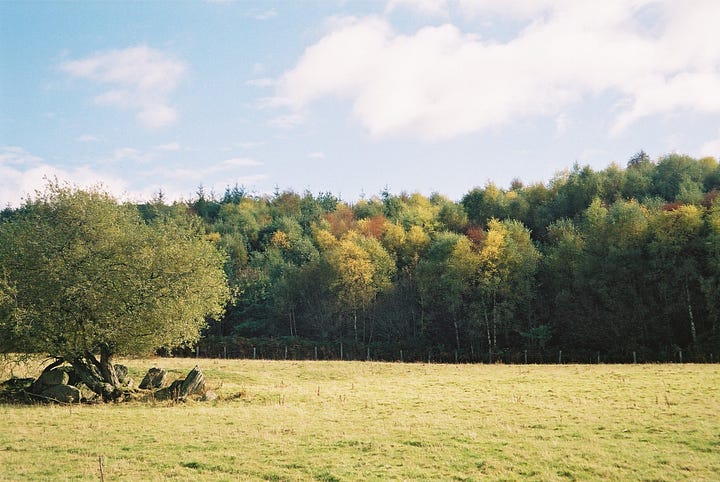
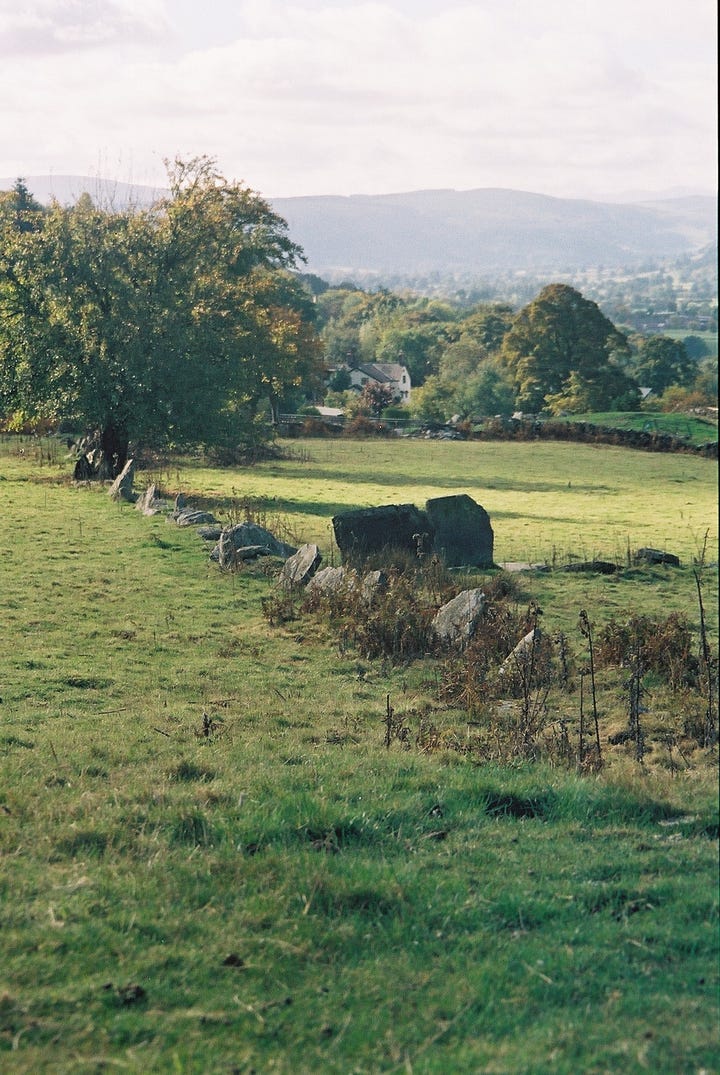
Another field that is quintessential to any visit to Hafod yr Afr is the “bottom field” (these fields used to have meaningful names, that are resurfacing through the research into the house’s history that we are so generously supported with locally - more on that another day!) The field-edge you have to traverse in your vehicle, to reach the woodland with a track you must then tackle, to reach the house itself. The opening with a gate is a barely visible break in the length of hedge running alongside the B road, a ‘layby’ hardly big enough to take a car, and the ritual of opening the gate which is sometimes done alone, sometimes by a helper - always, in our minds at that moment, the thought of: “We shall see what transpires!”
